Fri, 08/24/2012 - 13:15
#1
Pre War Models
Hi Gents,
I know it's foolish, and I know they are going to drop to bits one day, but my other main passion is Pre War Dinky.
I think this comes from years of longingly looking at the picture of John Hemley's superb Pre War collection in Cecil Gibson's Troy book "Commercial Vehicles" when I was a kid.
I never dreamed I would own any, but I have got 20 odd now, albeit not in good condition, here are a few...
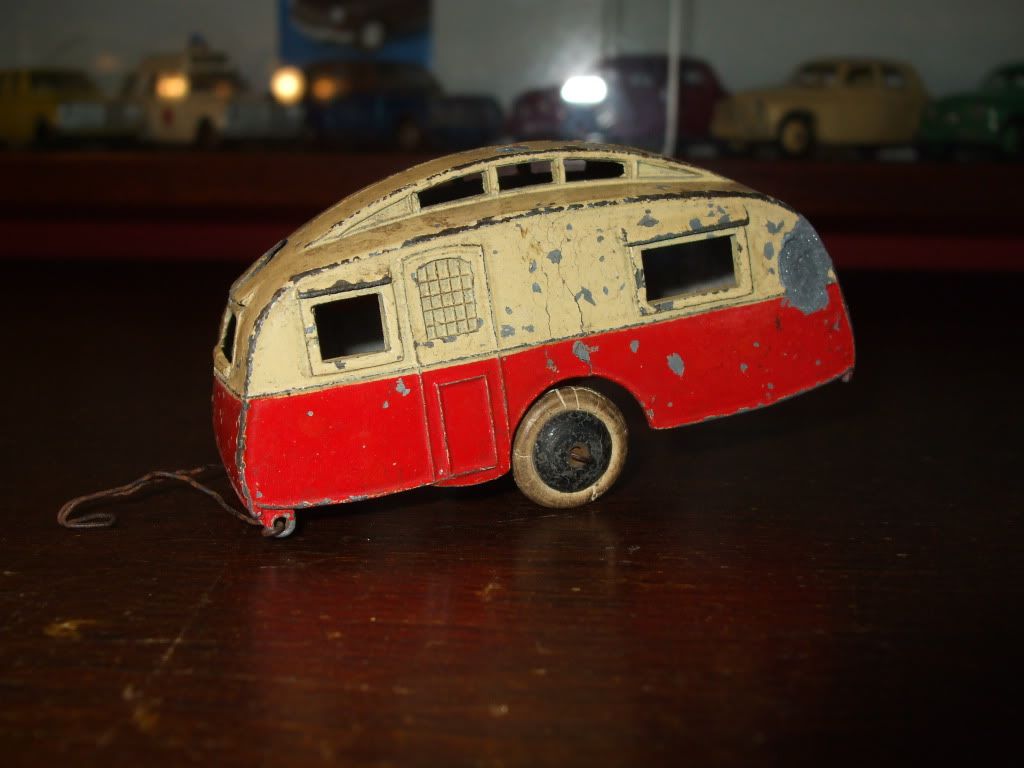



Chris Warr.
Sat, 08/25/2012 - 10:14
#2
A couple more...........
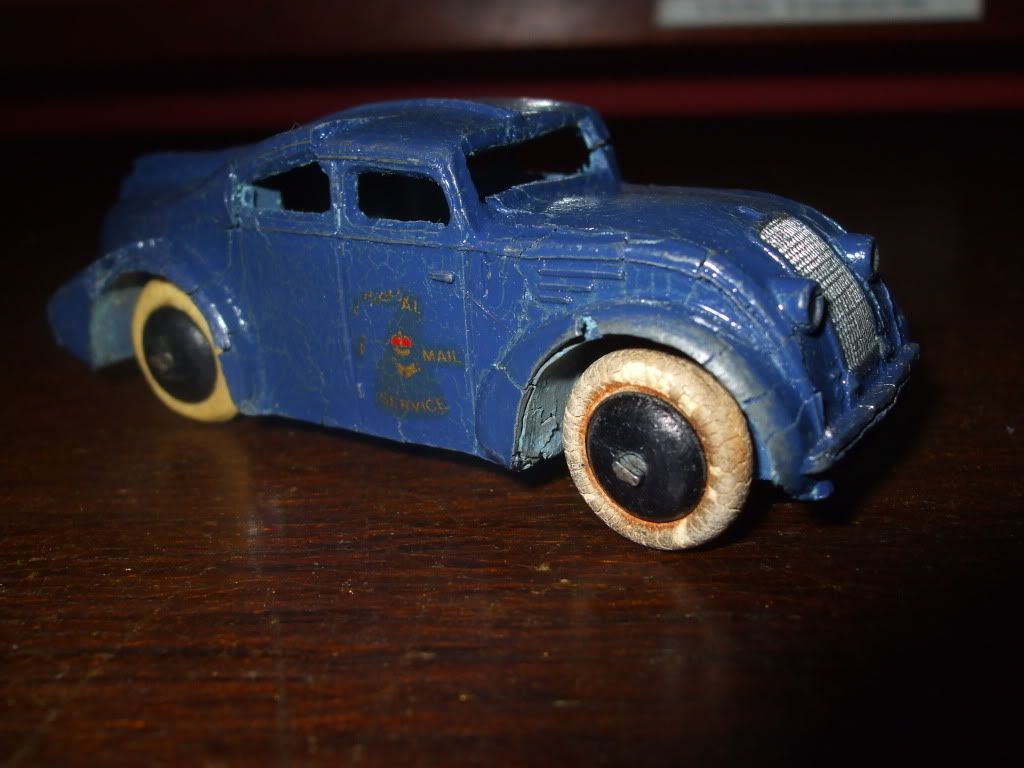


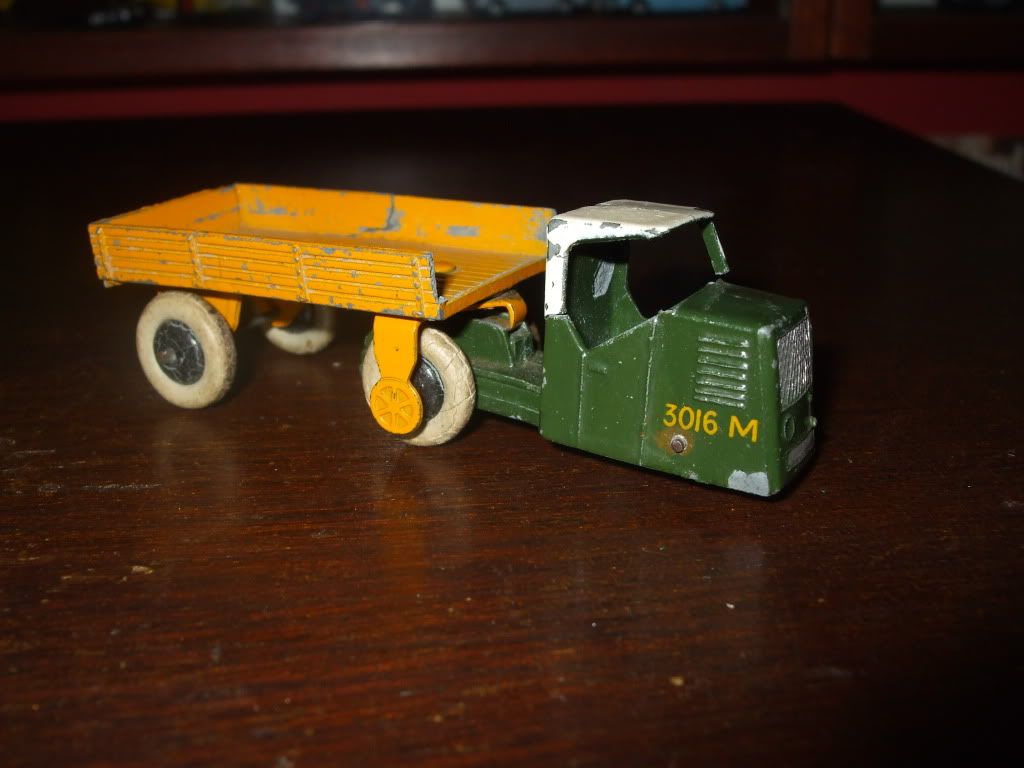
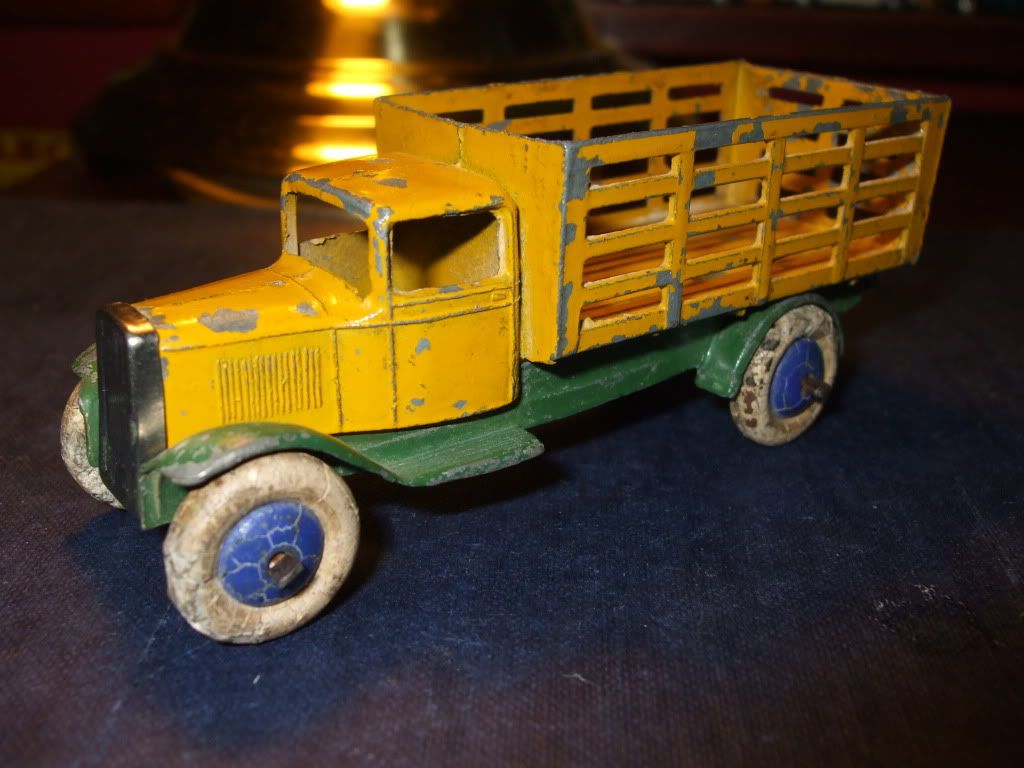

Chris Warr.
Sat, 08/25/2012 - 11:56
#3
Hi Chris. The Secotine van is superb ! It was my stick when I was in school !
Here are my pre-war items : only 3 trucks in bad conditions !
French Dinky or course !
Richard
Sat, 08/25/2012 - 18:33
#4
Hey Richard,
They are WONDERFUL, I love the French 25 Series, but have never seen any other than in pictures.
Unfortunately the 28 Seccotine van had lost it's back axle, so I sat it on a spare Post War one I had, looks a lot better that way.
Chris Warr.
Mon, 08/27/2012 - 11:32
#5
This is one of my 52a Queen Mary boats

I think she has been through too many storms
Dave
Mon, 08/27/2012 - 11:38
#6
This shows that the dreaded metal problem is not just associated to pre-war items.
On my 551 Large Trailer the rear wheels are fine but the two on the front axle are only being held together by the tyres.

This trailer was of course only made post war. It is not a huge problem on post war items but it does sometimes occur.
Dave
Mon, 08/27/2012 - 19:11
#7
Hi Dave, it is a worry, I have a couple of 1st series Fodens with the same problem. A Flat Tail lorry where the flatbed is so bent it has actually started to crack, I've released the fixing screw and washer to take the pressure off, but it's not looking good, my only hope is that it's taken 50 odd years to get this bad, so hopefully there's a decade or two left before I have to start looking for a cheap chipped cab chassis with a mint flatbed! And sadest of all a First Series Flat Chain lorry in Green that has actually cracked right across the bed leaving it in two pieces, and with a rear chain post broken off completely as well.
Chris Warr.
Mon, 08/27/2012 - 19:18
#8
Thankfully unlike the pre-war items the problems with post-war Dinky Toys is quite small.
Dave
Sun, 09/09/2012 - 07:27
#9
Very often the pre-war boxes are considerably better than the contents:
This view is very fine, isn't it?
And this comes out when removing the cardboard insert.
And it's even worse when showing the off-side. This model has three problems:
1. The well-known intergranular corrosion of the zamak parts (hubs, seachlight, crew).
2. The lesser known, rare use of iron for the body, which produces a lot of rust.
3. Extreme flattening of the tyres, another well known deficiency.
Still, I love this model because of the way it looks, is has the full period charm (if one can speak of 'charm' in case of these war machines).
I love the box and I would not even replace the flat tyres.
Sun, 09/09/2012 - 08:36
#10
You are absolutely right Jan the pre-war boxes are absolutely beautiful. Meccano put so much effort into these boxes, often with much valuable associated information printed on them. Also, the Meccano catalogues and other literature was of an equally high quality.
I agree with you in leaving the model just as it is.
Dave
Tue, 09/11/2012 - 18:47
#11
It's a beautiful piece, even with the damage, and the box looks mint! One I would love to have in my collection in any condition. Pre War Dinky just has so much charm, that's why I can't resist them.
Chris Warr.
Wed, 09/12/2012 - 18:26
#12
I don't have too many pre-war Dinky's, but do have a few nice ones:
This is the set of the Mechanical Horse and assorted trailers. Very fortunate that there is no sign at all of fatigue and even the tires are in good condition.




Wed, 09/12/2012 - 18:32
#13
Here are a few more that I acquired in the last few years. These have some small fatigue areas, but not bad at all. I also agree that the pre-war models have a charm all their own....the colors used then, the level of detailing (the figures with these have tiny painted features), and the wonderful boxes with colored scenes. I also like the use of tinplate on the pre-war models.




Wed, 09/12/2012 - 18:47
#14
These are truly stunning and the boxes are a tue work of art.
Dave
Thu, 09/13/2012 - 06:34
#15
Dave--
Thanks....I had never paid much attention to pre-war Dinky's until a few years ago. It is a wonderful period of Dinky history, and many models were either changed or discontinued after the war. I think every serious Dinky collector should invest in at least a few of these; they are real treasures, and to find a very nice one is a thrill.
Terry
Thu, 09/13/2012 - 07:27
#16
Hi Terry, I think every serious Dinky collector will fully agree with you, but I think far fewer of them will be able to afford it.
Nevertheless, I feel very privileged to be able to afford a not-too-expensive one every now and then. Still, I never see a Dinky as any kind of 'investment'.
Kind regards, Jan
Thu, 09/13/2012 - 07:34
#17
Jan--
Thanks for the comments. When I said invest, I did not mean to buy them for investment reasons, but used investment to mean spending the money necessary to acquire them. You are quite correct; any of the pre-war models in great condition are going to be expensive, so for most of us it means we can only get a few...that is certainly my situation! I have never bought any Dinky's as an investment, although my wife certainly thinks they are! I have bought them because I just love them and the long gone era they represent, when you and I were kids.
Thu, 09/13/2012 - 09:44
#18
Hi Terry, I fully understand what you mean and I was convinced of your true dedication to our beloved hobby already. You do a marvellous job collecting these. For us the challenge and the task to study, write about them and and to save them to future generations. The more pre-war models displayed here the better!
Kind regards, Jan
Fri, 09/14/2012 - 16:40
#19
Hi Gents,
Couldn't agree more!
I avoided Pre War models for years because of the stories of them dropping to bits before your eyes etc, in the end I took the plunge and now have 20 plus including some that are very fragile, however I have had my first 28 Series Vans for nearly 20 years, and they have not deteriorated that I can see in that time.
I like to think that the Pre War models are the real original Dinky Toys, the only ones made in Frank Hornby's lifetime, and aimed at the top end / quality 0 Gauge Trainset buyer, a market that was simply gone by 1945, and the models themselves were never quite the same again were they?
Here's a couple more............




Chris Warr.
Sun, 09/16/2012 - 20:40
#20
Chris--I agree...although I dearly love the Dinkys of post war, up until about 1960, the pre-war models just have something that was mostly lost after the war. To me part of it is the quaint liveries that were in use earlier...the logos and names evoke a past time when lives and the world were different. And the models themselves, while pretty accurate, also have a certain quaintness to them that is just charming.
Those latest pictures you sent are wonderful....I love the railroad liveries that were on those Mechanical Horses at that time...thanks for posting and sharing!
Terry
Fri, 09/21/2012 - 20:08
#21
Can anybody confirm whether the UK 25b Covered truck was ever issued in a military green prior to 1939, and sold as such. I always believed that the type 4 base were issued as military for a South African order between 1948--50. I have never seen an earlier type 2or 3 chassis as a military offering.Yet there is a Canadian collector who claims to have an example. Although the picture he shows, both the tin tilt and wheel hubs appear to show a different colour to the body.
Fri, 09/21/2012 - 20:32
#22
Replying to my own question, I have looked at the achive's and discovered that there was an item issued in mil green gloss, but that it is most certainly not a military issue, so this chap in Canada has not got an ultra rare model as he claims. His claim regarding the South African issue is wrong also, they did not have silver headlights.
Fri, 09/21/2012 - 20:52
#23
As far as I know the 25b was only issued as a civilian model pre war. There is some confusion here as the gloss dark green used on some of these has faded over the years to almost an Army matt finish.
Again as far as I know the SA military issue was a special, and these were only exported after the war.
I could as ever be surprised at what is out there though.........
Chris Warr.
Fri, 09/21/2012 - 21:21
#24
This one was bought in the De Bijenkorf department store in Amsterdam in 1939.
It is badly fatigued and the front wheel unit has been replaced, but the rest is all original ...


Kind regards, Jan
Thu, 10/04/2012 - 15:26
#25
janwerner wrote:
"This one was bought in the De Bijenkorf department store in Amsterdam in 1939.
It is badly fatigued and the front wheel unit has been replaced, but the rest is all original ...


Kind regards, Jan"
That's a beauty Jan! It sure looks like an Army lorry doesn't it?
CW.
Thu, 10/04/2012 - 20:30
#26
Well, Chris, a beauty, OK, of a certain kind!
Yes it is definitely an army wagon, in fact a no. 25bm. But I have been enquiring about this model for many years already and I still have never seen or heard of this specific pre-war type. I'm still waiting for someone to report of another example.
It is not announced, neither in MM nor in the catalogues as far as I know. My friend is not interested in its scarcity, it's just a dear memory piece for him (of course).
Yes, it is badly fatigued, deformed and fragile. I returned to my friend for making a digital photo of the model some ten years later and found it in this state of continuing deterioration!
Kind regards, Jan
Fri, 10/05/2012 - 08:10
#27
Hi Jan,
What a terrible shame that this lovely piece is slowly falling apart, I had no idea there was a Pre War military 25 Series, but it makes sense that when Meccano introduced more RAF planes etc in 1939 that more military vehicles would follow, I guess there weren't more as they pretty much sold off the '39 made stock in '40 and went over to war production.
I find this whole period facinating,and am always amazed at what turns up, it's what makes the Pre War era so much of a challenge isn't it?
I've just picked up a couple of Pre War race cars that were found amongst others in a box in a garage where they had sat for about 75 years, it just goes to show that these are STILL out there.........
Chris Warr.
Mon, 10/08/2012 - 19:22
#28
Hi Gents,
Found these recently, Silver Jubilee / Express Passenger Train set ....

and a spare coach in a two tone green I haven't seen befpre, wish I had the rest of it!

CW.
Wed, 10/10/2012 - 18:51
#29
Mentioned above I picked up a couple of Pre War racers that had been in a box in a garage all this time, here they are,
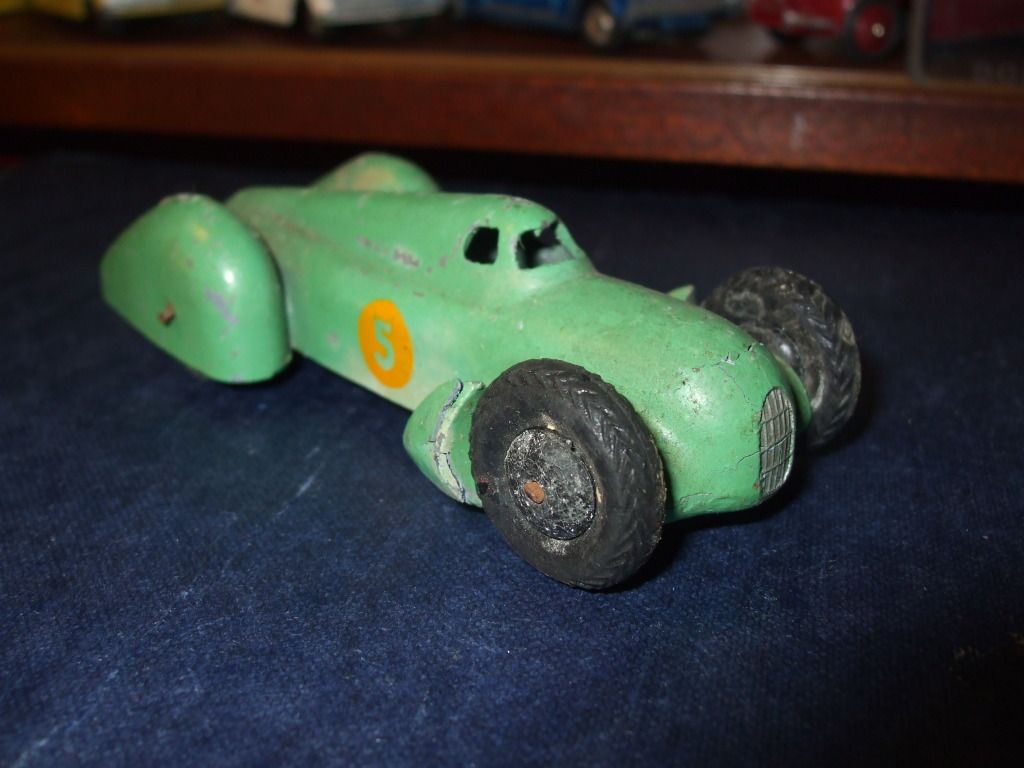
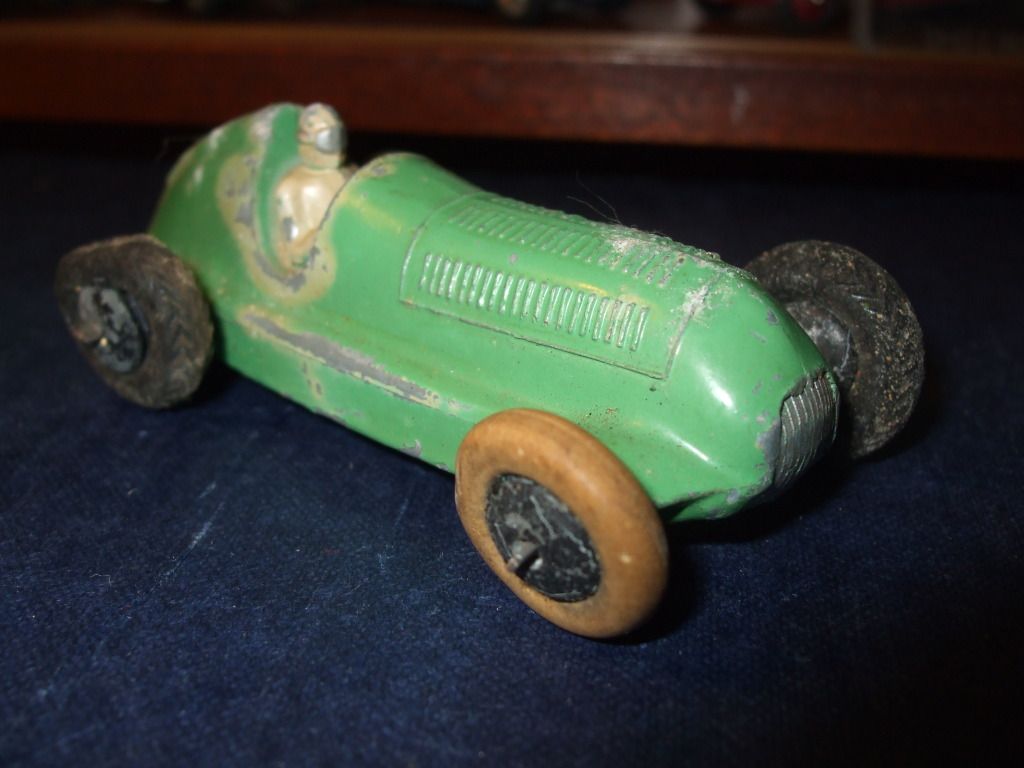
The Merc has a 70+ year old replacement tyre too!
Chris Warr.
Wed, 10/10/2012 - 23:32
#30
Chris--
Both of those look to be in quite good condition...wonderful find!
Terry
Thu, 10/11/2012 - 07:27
#31
Nice acquisitions!
Sometimes I like the exciting pioneer stories behind as much as the pre-war models themselves. This is (a part of) the story behind the no. 60w 'Clipper III' Flying Boat, one of my favourite pre-war aircraft models:
The model was introduced in 1938, in the glory days of Dinky Toys aircraft models. The aviation scene was very exciting indeed in those days. Pioneer trans-oceanic crossings were made and stunning records were broken, in an era in which flying was anything but common for the ‘ordinary people’.
This flying boat was of medium size, compared with other Dinky aircraft models. Still, the construction was rather complicated. A separate wing was rivetted to the main part, consisting of the fuselage, wing pylon and tail, including the two vertical rudders. The real one was even more complicated, the main wing being supported by a system of supports, keeping it in balance on top of the extremely narrow pylon top.
The prewar version had a flying game eye, protruding down throught the fuselage, next to the single red plastic roller and the two rivets keeping the wing attached to the fuselage.
The name was ‘Pan American Airways Clipper III’ underneath, but post-war the cast-in name was changed into simply ‘Flying Boat’.
Although registration numbers often seem to have been applied by transfer technique, this one appears to have been stamped on the wing. The surrounding beading if the letters and numbers prove that this one is stamped on. By the way, Ramsay’s mentions a second version, not showing USA NC16736, but showing NC16736 only, which is said to be a special US issue.
The model was packed in such a nice faint blue pre-war lid box, with explanation on the lid. It is a model of a Sikorsky (not famous for helicopters yet) S42B (and not S-24-B as stated in Sue Richardson’s reference work, or S32 as stated in Ramsay’s 11th ed.). The model also came as a part of the set box no. 65, the Presentation Aeroplanes Set, including nos. 60r, 60t, 60v, 60w, 62n, 62p, 62r and 62w, which was available 1939-1941.
Undoubtedly for those who followed aviation in the 1930s one of the reasons to model this aircraft was the famous transatlantic crossing, as referred to on the box lid. But things were not that easy as stated in those two lines on the box. There were some obstacles for transatlantic crossings these days. The main obstacle was that Britain did not want the United States to have a monopoly — or even a head-start — on a transatlantic airline service, and refused to grant landing rights in Britain itself or the British-controlled stepping stone across the Atlantic, such as Atlantic Canada and Bermuda. Similar rivalry from Portugal also frustrated attempts to inaugurate a southern route with stops in the Azores and Lisbon on the southern route. The British insisted on reciprocity, and would not grant landing rights to an American airline until Britain’s Imperial Airways was able to commence a similar service. On January 25, 1936, Juan Trippe and George Woods-Humphrey, Managing Director of Imperial Airways, signed an agreement dividing transatlantic service between Pan American and Imperial Airways; the agreement eliminated competition from other airlines, such as the Dutch, French, and Germans, who were barred from the British stepping stones across the Atlantic, but it provided that neither Pan Am nor Imperial Airways could begin service until both airlines able to do so. Since Britain was far behind America in flying boat technology, and Imperial Airways did not have any aircraft capable of transatlantic service in 1936, Pan American would have to wait more three years before its planes could fly the Atlantic.
The first crack in the wall of British resistance occurred in early 1937, under the threat of competition from airships and alternative technologies, such as the German sea-air catapult mail service, which did not require landing permits on British-controlled territory. Pan Am began construction of flying boat bases Baltimore, New York City, and Port Washington, Long Island, and other bases were built at Shediac, in the Canadian province of New Brunswick; Botwood in Newfoundland, not far from Gander Lake; and at Foynes, on the River Shannon in Ireland.
The Clipper III – as the name indicates – was not the only Clipper, a name that was used frequently for PanAm planes. The first Clipper, the S-40 was delivered to Pan Am on October 10, 1931. It was flown to the Anacostia Naval Air Station at Washington D.C. to be christened by Mrs. Herbert Hoover the American Clipper. After Mrs. Hoover smashed a bottle of water from the Caribbean on the nose of the plane, Trippe called it a ‘flagship’, and ‘the first American example of the great airliner of tomorrow that will speed trade and good will among nations.’ The Clipper designation was born.


The Clipper III was manufactured by the Vought-Sikorsky Aircraft Division of the United Aircraft Corporation in Stratford, Connecticut. The S-42 first flew on March 30, 1934. A total of 10 aircraft were built. These were the first of the great Pan American Airways Clipper Flying Boats and the first true over ocean transport. Model S42A upgraded engines, an improved airfoil, an increased wingspan, a stronger and lighter aluminum alloy skin, a larger gross weight and useful load and convertible sleeping accommodations for 14 passengers; Four aircraft built to this configuration. The Model S42B, the Dinky Toy, made additional aerodynamic improvements, increase in gross weight, improved fuel capacity and thus distance, and the addition of constant speed propellers enhanced the performance. Only Three were built to this configuration. The Sikorsky S-42 is regarded as the first truely American seaplane and was described as the ‘most beautiful aircraft of its time.’
(many of these words are not my own wisdom, for more details see: http://www.flyingclippers.com/S42.html and http://www.clipperflyingboats.com/ )
Kind regards, Jan







-073 Land Rover, Horse Box and Horse (1960-67)
DTCAwebsite upgrade 2023
DTCAwebsite upgrade 2023
-105c and 383 4-Wheel Hand Truck (1949-1958)
-105c and 383 4-Wheel Hand Truck (1949-1958)
DTCAwebsite upgrade 2023
DTCAwebsite upgrade 2023
DTCAwebsite upgrade 2023
DTCAwebsite upgrade 2023
DTCAwebsite upgrade 2023
DTCAwebsite upgrade 2023
DTCAwebsite upgrade 2023
DTCAwebsite upgrade 2023
DTCAwebsite upgrade 2023
DTCAwebsite upgrade 2023
DTCAwebsite upgrade 2023
DTCAwebsite upgrade 2023
DTCAwebsite upgrade 2023
--22c Motor Truck (1933-50)
--22c Motor Truck (1933-50)
DTCAwebsite upgrade 2023
DTCAwebsite upgrade 2023
Trailer Caravans
Trailer Caravans
DTCAwebsite upgrade 2023
DTCAwebsite upgrade 2023
DTCAwebsite upgrade 2023
DTCAwebsite upgrade 2023
Trailer Caravans
Trailer Caravans
-138 Hillman Imp (1963-73)
-537 Renault 16 TL
-189 Triumph Herald Saloon (1959-64)
-255 Mersey Tunnel Police Van (1955-61)
DTCAwebsite upgrade 2023